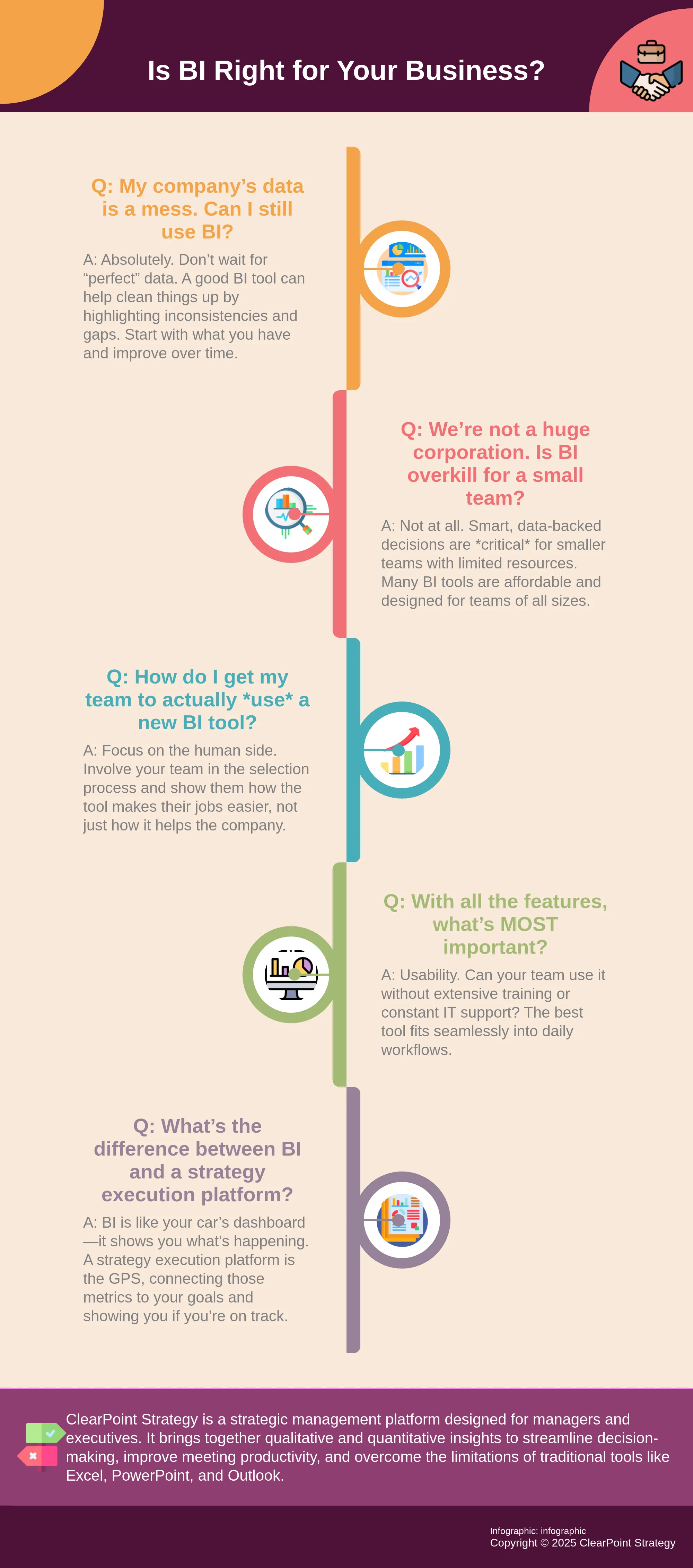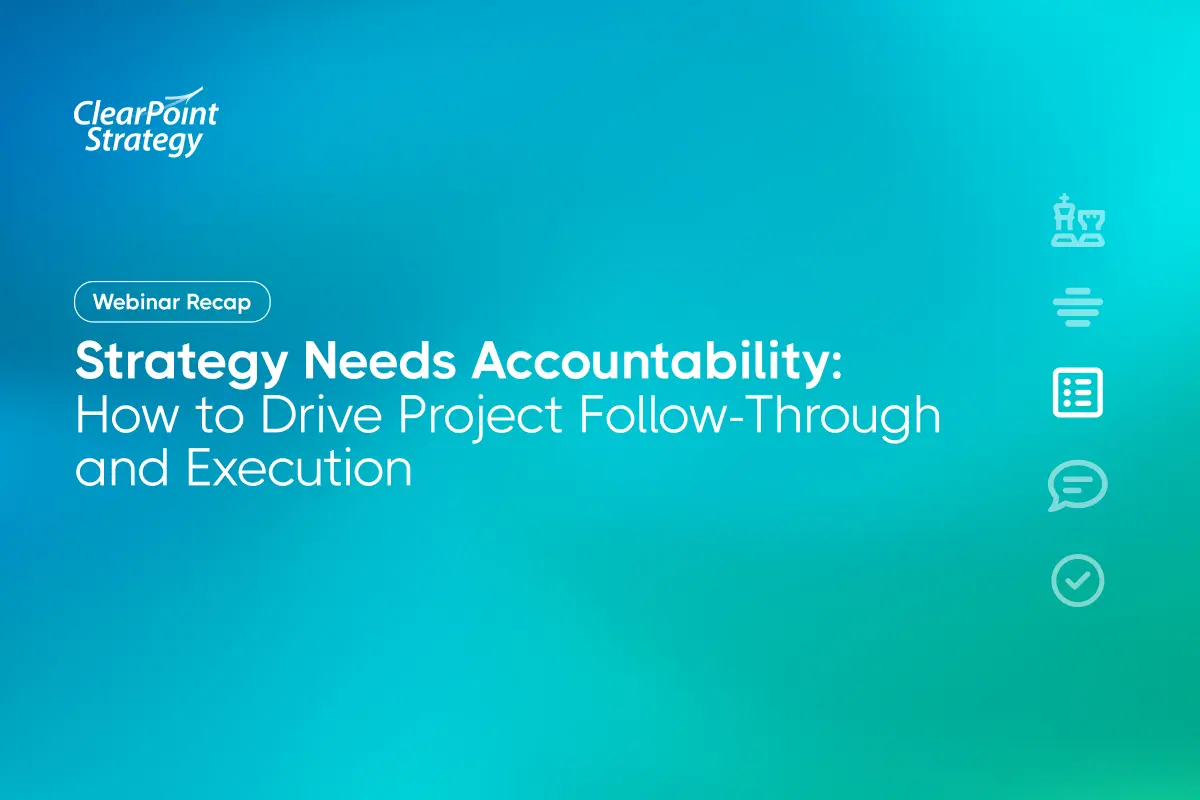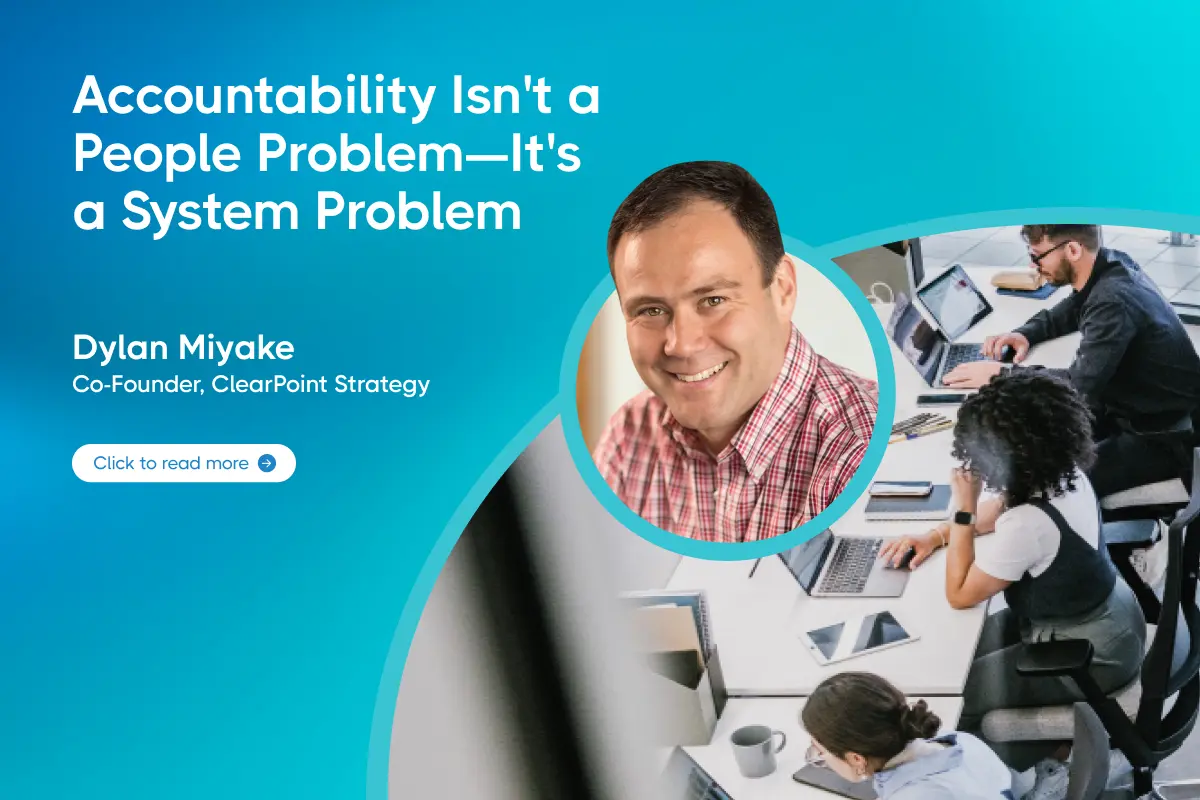Explore the top BI business intelligence software of 2025, featuring key tools and insights to help your organization make smarter, data-driven decisions.
In today's competitive world, the quality of your decisions is what separates industry leaders from everyone else. Flying blind is no longer an option. Without a clear, data-backed view of your performance, you're essentially making educated guesses while your competitors are making calculated moves. This is the fundamental problem that bi business intelligence software is designed to solve. It’s not just about creating charts; it’s about gaining the visibility to spot new opportunities, understand customer behavior, and streamline operations with confidence. It’s about shifting from reacting to last quarter's sales report and wondering what went wrong, to analyzing the trends that led to that result and adjusting your strategy execution accordingly. This is the essence of smart efficiency—using the right tools to gain insights that allow you to work smarter, not just harder.
Key Takeaways
- Focus on Strategy, Not Just Data: A great BI tool does more than visualize numbers; it connects them to your strategic goals. Choose a platform that helps you understand the why behind your performance and guides your team toward the right actions.
- Prioritize Usability for Your Team: The most powerful software is useless if no one uses it. Involve your team in the selection process and pick a tool with an intuitive interface to ensure it becomes a daily asset rather than a complex chore.
- Build a Data-Driven Culture to See Real ROI: Technology alone doesn't create change. True success comes from making data a core part of your team's decision-making process through consistent training, clear governance, and showing how insights solve real problems.
What is Business Intelligence (BI) Software, Really?
If you feel like you're swimming in an ocean of data but can't find a single drop of useful insight, you're not alone. It’s a common frustration for leaders who have access to more information than ever but struggle to connect it to their strategy. This is where Business Intelligence (BI) software comes in. At its core, BI is a category of software that acts as your organization's data translator. It gathers the raw, often chaotic, language of data from all your different systems—sales figures, marketing analytics, customer feedback, operational metrics—and turns it into a clear, coherent story.
Think of it as a sophisticated GPS for your business. A simple map might show you the terrain, but a great BI tool analyzes traffic patterns (market trends), suggests the fastest routes (opportunities for growth), and alerts you to roadblocks (potential risks) before you encounter them. It’s a collection of technologies designed to help you collect, analyze, and present information in a way that supports better business decision-making. Ultimately, BI software helps you answer the critical questions: "What happened?", "Why did it happen?", and most importantly, "What should we do next?"
And Why Should Your Business Care?
So, why does this matter? Because in today's competitive landscape, the quality of your decisions is what separates industry leaders from everyone else. Flying blind is no longer an option. Without a clear, data-backed view of your performance, you're essentially making educated guesses while your competitors are making calculated moves. BI software gives you the visibility to spot new opportunities, understand customer behavior, and streamline operations with confidence.
It’s about shifting from being reactive to proactive. Instead of just looking at last quarter's sales report and wondering what went wrong, you can analyze the trends that led to that result and adjust your strategy execution accordingly. This is the essence of smart efficiency—using the right tools to gain insights that allow you to work smarter, not just harder.
The Must-Have Features of Any Great BI Tool
When you start looking at business intelligence software, you’ll quickly notice that every platform promises to turn your data into gold. But let's be honest—not all tools are created equal. A great BI tool does more than just spit out charts; it becomes an extension of your strategic mind, helping you see the story hidden within the numbers. It’s the difference between having a pile of raw ingredients and a Michelin-star chef who can turn them into a masterpiece.
So, what features truly separate the helpful from the hype? It’s not about having the longest list of bells and whistles. It’s about having the right capabilities that empower your team to work smarter, not harder. Think of it like a well-equipped toolkit. You need more than just a hammer. You need the right instruments to measure, cut, assemble, and refine. A powerful BI platform gives your team the specific tools they need to build a clear picture of your business performance, connect insights to action, and confidently answer the question, “What should we do next?” Below are the non-negotiable features that every great BI tool should offer.
Visualize Your Data in a Meaningful Way
Raw data is just a sea of numbers. To make sense of it, you need to see it. Effective data visualization is the first step in transforming complex datasets into clear, actionable insights. A great BI tool provides a rich library of charts, graphs, and maps that bring your data to life. But it’s not just about making things look pretty—it’s about revealing patterns, trends, and outliers that would be impossible to spot in a spreadsheet. This visual clarity allows you to understand business performance at a glance and helps you make smarter, data-driven decisions without needing a degree in data science.
Create Reports and Dashboards That Tell a Story
Visualizations are the words, but reports and dashboards are the story. The best BI tools let you assemble your charts and metrics into interactive dashboards that tell a compelling narrative about your strategy. Instead of static, one-off reports, you can create dynamic views that allow leaders to explore the data themselves. A well-designed dashboard doesn't just present what happened; it explains why it happened and guides your team toward what to do next. This storytelling capability is crucial for aligning everyone, from the C-suite to the front lines, around a shared understanding of your strategic goals and progress.
Connect All Your Data Sources Seamlessly
Your organization's data probably lives in a dozen different places—your CRM, financial software, marketing platforms, and countless spreadsheets. A top-tier BI tool acts as a central hub, seamlessly connecting to all these disparate sources. This integration is critical for creating a single source of truth. When everyone is working from the same complete and up-to-date information, you eliminate the confusion and conflicting reports that come from data silos. This ensures that your strategic conversations are based on reality, not guesswork, and that your performance tracking is always accurate.
Go Beyond the Basics with AI and Advanced Analytics
Modern BI tools are moving beyond simply showing you what happened in the past. They now leverage artificial intelligence (AI) to help you see the future. Features like predictive analytics and forecasting use historical data to identify what’s likely to happen next, giving you a powerful strategic advantage. Some platforms even allow you to ask questions in plain language and get AI-generated answers and visualizations instantly. According to a report from McKinsey, companies that utilize AI are already seeing significant performance gains, making these advanced analytics a must-have for any forward-thinking organization.
Empower Your Team with Self-Service BI
In the past, getting a new report often meant filing a ticket with the IT department and waiting. Today, the best BI platforms offer self-service capabilities that put the power of data directly into the hands of your business users. With an intuitive, user-friendly interface, team members can build their own reports, explore data, and find answers to their own questions without needing technical assistance. This not only speeds up decision-making but also fosters a culture of curiosity and accountability. When everyone on your team feels empowered to use data, you create an environment where insights can come from anywhere.
Keep Your Data Secure and Compliant
As you bring all your valuable data into one place, security becomes paramount. A great BI tool must have robust security features to protect your sensitive information. This includes user-based permissions that control who can see what, ensuring that employees only have access to the data relevant to their roles. Furthermore, the platform must help you adhere to data privacy regulations like GDPR and HIPAA. Strong data governance and security aren't just technical requirements; they are the foundation of trust. Your team needs to be confident that the data they are using is both accurate and secure.
A Look at the Top BI Software on the Market
The business intelligence market is full of options, and frankly, it can be overwhelming to sort through them all. Each tool comes with its own philosophy on how to handle data, and the best one for you really depends on your team’s specific needs, technical skills, and strategic goals. Are you looking for a simple way to create dashboards, or do you need a heavy-duty platform that can predict future trends?
To help you get a clearer picture, I’ve put together a look at some of the top players in the BI space. Think of this as a field guide to help you identify the right solution for your organization’s unique challenges. We’ll cover everything from user-friendly visual tools to powerful enterprise systems, giving you the information you need to make a confident choice. This isn’t about finding a single “best” tool, but about finding the tool that best fits the way your team works and the strategic outcomes you’re trying to achieve.
ClearPoint Strategy
While many BI tools are fantastic at showing you what is happening with your data, ClearPoint Strategy is designed to help you understand why it’s happening and what you should do next. It’s less of a traditional BI platform and more of a strategy execution software that uses BI principles to connect your data directly to your strategic goals. Instead of just presenting charts, ClearPoint links your key metrics to the projects and people responsible for them, creating a clear line of sight from daily activities to long-term success. It’s built for leaders who need to not only see the data but also drive action and ensure the entire organization is aligned and moving in the right direction.
Microsoft Power BI
If your organization already operates within the Microsoft ecosystem, Power BI is a natural fit. It excels at pulling data from various sources and transforming it into clean, interactive reports. Its AI features are particularly useful, allowing you to find patterns and even ask questions in plain language to get immediate answers. For businesses invested in Microsoft 365, the integration is seamless. A Forrester study highlighted its financial impact, finding that companies saw a significant return on their investment over three years, making it a compelling option for those focused on tangible results and a unified tech stack.
Tableau
Tableau has built its reputation on powerful and intuitive data visualization. It’s a favorite among teams who want to explore their data visually without needing constant support from an IT department. Think of it as a digital canvas that empowers your team to create rich, interactive dashboards that tell a compelling story. By making data analysis more of a creative discovery process, Tableau helps uncover insights that might be missed in traditional spreadsheets or static reports. This focus on visual analytics is critical in a business world where, as experts at Harvard Business Review note, a good visualization can communicate complex ideas far more effectively than words alone.
Qlik Sense
Qlik Sense stands out with its unique AI-powered engine that helps you find connections in your data you might not have thought to look for. It’s a highly flexible platform that works beautifully across all devices, making it a great choice for teams that need access to insights on the go, especially on touchscreens. You can ask questions using normal language and let the AI guide you to relevant charts and insights. This makes data exploration feel more like a conversation than a technical task. For organizations looking for a modern, intuitive BI tool that encourages curiosity and uncovers hidden relationships within their data, Qlik Sense is a strong contender.
SAP BusinessObjects
For large organizations with complex reporting needs, SAP BusinessObjects is an enterprise-grade powerhouse. It offers a comprehensive suite of tools for everything from detailed, pixel-perfect reports to interactive data analysis and dashboards. This is a robust, feature-rich platform designed to handle the demands of a large-scale operation. However, that power comes with a certain level of complexity and a higher price tag. It’s best suited for companies that have the resources to manage a sophisticated BI environment and require the deep analytical capabilities that SAP has been known to provide for decades.
Domo
Domo is a fully cloud-based platform designed to bring data together from a huge number of sources, making it a central hub for all your business metrics. It’s used by companies of all sizes, from nimble startups to large enterprises, and offers powerful features like predictive analysis to help you look into the future. Because it’s so comprehensive, there can be a bit of a learning curve to get the most out of it. However, for organizations struggling to unify data from dozens of different systems—from social media to finance—Domo provides a powerful solution to create a single source of truth.
IBM Cognos Analytics
IBM Cognos Analytics leverages AI to dig deep into your data and surface insights that might otherwise remain hidden. It’s designed to help you understand the story behind the numbers by automatically finding patterns, identifying relationships, and suggesting relevant visualizations. This AI-driven approach acts almost like an analyst's assistant, guiding your exploration and helping you focus on what matters most. While it may take some time to master all of its advanced features, the investment can pay off for teams that need to perform deep, sophisticated analysis and want an AI partner to help them uncover every possible insight.
Oracle Analytics Cloud
When it comes to handling massive amounts of data, Oracle Analytics Cloud is a heavyweight contender. Built for large enterprises, this robust platform provides a full spectrum of business intelligence capabilities, from data preparation and visualization to advanced analytics. It’s particularly strong in environments where organizations need to analyze enormous datasets without sacrificing performance. If your company operates at a scale where data volume is a primary concern, Oracle’s BI solution offers the power and scalability required to manage and analyze your information effectively, ensuring your analytics infrastructure can grow with your business.
SAS Business Intelligence
SAS has a long and respected history in the world of analytics, and its BI platform is particularly known for its strength in predictive modeling. It’s a tool for organizations that want to go beyond historical reporting and use their data to forecast future trends and outcomes. SAS helps you make smarter, data-driven decisions by providing a statistically rigorous foundation for your analysis. For businesses in fields like finance or healthcare, where accurate forecasting is critical, the advanced analytical capabilities of SAS make it a trusted and reliable choice for shaping future strategy.
Sisense
Sisense is designed to make data analytics accessible to everyone in an organization, not just the data scientists. It’s known for being fast and easy to use, allowing non-technical team members to independently manage and analyze large, complex datasets. This approach helps break down the traditional bottlenecks that can slow down decision-making. By empowering more people to work directly with data, Sisense helps foster a culture of data literacy and enables teams across the company to find their own answers and insights without having to wait for IT to run a report.
How the Top BI Tools Stack Up
Choosing a BI tool can feel a lot like car shopping. One has incredible horsepower, another gets amazing gas mileage, and a third has that sleek design you love. The "best" one really depends on where you're going and who's coming with you. The same is true for BI software. The perfect tool for a data science team at a Fortune 500 company is likely overkill for a marketing department that just needs clear, actionable dashboards. To help you look under the hood, let's break down how the top tools compare on the things that matter most: features, price, and what actual users have to say.
Compare Key Features
When you start comparing BI tools, you'll notice they often fall into a few different camps. For teams focused on powerful, interactive data visualization, some tools excel at turning complex datasets into intuitive charts and dashboards that empower users to explore insights without needing a technical background. On the other end of the spectrum, you have enterprise-grade solutions that offer incredibly deep and comprehensive reporting capabilities, though they can come with a steeper learning curve. Then there are cloud-native platforms that focus on integrating data from hundreds of different sources, making them a central hub for all your business metrics. The key is to match the features to your team's specific needs, not just chase the tool with the longest feature list.
Understand the Pricing Models
Let's talk about money, because the way BI tools are priced can have a huge impact on your budget and ability to scale. The most common model you'll see is a per-user subscription, where you pay a monthly or annual fee for each person who needs access. This is straightforward but can get expensive as your team grows. Some vendors offer flat-fee pricing, which gives you a predictable cost regardless of user count, while others use a usage-based model tied to data volume. It’s critical to think about your future needs. Will you be rolling this out to a small team or the entire organization? Answering that question will help you see which pricing structure aligns with your growth plans and prevents unexpected costs down the road.
Hear from Real Users
A feature list can tell you what a tool can do, but user reviews tell you what it’s like to do it. This is where you get the real story. For instance, while some tools are celebrated for their stunning visualizations, users often mention a significant learning curve. In contrast, other platforms are frequently praised for their simplicity, making them a favorite among non-technical teams who need to get up and running quickly. Reading user feedback helps you understand the day-to-day reality of a platform. It’s an essential step in building a data-first culture, because if a tool is too complex for your team to use, it doesn't matter how powerful it is—it will just end up collecting dust.
How to Choose the Right BI Tool for Your Team
With so many options on the market, picking the right business intelligence tool can feel a bit like navigating a maze. It’s tempting to just go with the most popular name or the one with the flashiest features. But I’ve learned that the best BI tool isn’t a one-size-fits-all solution; it’s the one that fits the unique rhythm of your organization. Think of it less like buying a product off the shelf and more like hiring a new, data-savvy team member—you need to find the right fit for your culture, your existing systems, and your future ambitions.
Choosing a BI platform is a strategic decision that will shape how your team interacts with data for years to come. It’s about empowering your people with the insights they need to make smarter, faster decisions that move the needle. Let’s walk through the key considerations to ensure you select a platform that doesn’t just present data, but actually helps you execute your strategy.
Assess Your Organization's True Needs
Before you even look at a demo, take a step back and ask a fundamental question: What problem are we actually trying to solve? BI tools are fantastic for helping businesses understand trends and get answers from their data, but that can mean different things to different teams. Are you struggling with manual reporting that eats up hours every month? Do your leaders lack a clear, real-time view of performance against strategic goals? Are different departments working from conflicting data sets? Get specific about your pain points and objectives. This initial discovery phase is the most critical step; it ensures you’re solving for your actual business needs, not just adopting new technology for technology’s sake.
Consider Scalability and Performance for the Future
The BI tool that works for you today must also work for you tomorrow. Your data volume will inevitably grow, your team will expand, and your strategic questions will become more complex. A platform that can’t keep up will quickly become a bottleneck. When evaluating options, ask about their ability to handle increasing data loads and a growing number of users without a drop in performance. Think about your five-year plan. Will you be adding new product lines or entering new markets? Your BI solution needs the architectural runway to support that growth, ensuring your analytics capabilities remain a competitive advantage, not a technical limitation.
Ensure It Integrates with Your Current Systems
A BI tool should be a bridge, not another island. If it doesn’t connect seamlessly with the systems you already use—your CRM, ERP, and financial software—you risk creating more data silos. The last thing you want is a BI platform that requires your team to spend hours manually exporting and importing spreadsheets. Map out your existing tech stack and prioritize tools with native integrations or a flexible API. The goal is to create a single source of truth where data flows automatically, giving your leaders a holistic view of performance. A well-integrated system not only saves time but also builds trust in the data, which is the foundation of any successful data-driven culture.
Plan for User Adoption and Training
You can invest in the most powerful BI software in the world, but it’s worthless if your team doesn’t use it. User adoption is often the biggest hurdle, and it’s one you need to plan for from the very beginning. Success hinges on more than just technology; it requires a thoughtful change management strategy. Involve your end-users in the selection process to build buy-in and ensure the tool you choose is intuitive for non-technical team members. Once you’ve made a choice, develop a comprehensive training plan. By investing in your people, you ensure your new BI tool becomes an indispensable part of their daily workflow.
Your Guide to a Smooth BI Implementation
So, you’ve picked out a shiny new BI tool. That’s a great first step, but the journey doesn’t end there. Getting that software up and running—and actually used by your team—is where the real work begins. Think of it like buying a top-of-the-line GPS for a road trip. It’s a fantastic piece of tech, but it’s not much use if you don’t plug in the right destination, make sure it has a signal, and convince your co-pilots to actually follow the directions. A smooth implementation requires a bit of foresight and a clear plan to avoid common bumps in the road. Let’s walk through how to make your BI rollout a success story, not a cautionary tale.
Overcome Common Implementation Hurdles
Let’s be honest: bringing a new tool into an organization can be tricky. One of the first hurdles is simply choosing the right software in the first place; a poor fit can lead to a frustrating and costly dead end. Another classic challenge is integrating the new tool with your existing systems. If your data is scattered across different departments in isolated "silos," your BI tool can't create a unified picture. It’s like trying to assemble a puzzle with pieces from five different boxes. But perhaps the biggest hurdle is getting your team on board. A powerful BI platform that no one uses is just an expensive icon on a desktop. Overcoming these issues requires a thoughtful change management strategy that focuses on communication and training from day one.
Manage Your Data Quality and Governance
Your BI tool is only as good as the data you feed it. It’s the classic “garbage in, garbage out” scenario. If your data is inaccurate, incomplete, or outdated, your fancy dashboards will just give you beautifully designed, but ultimately wrong, answers. This is where data governance comes in. Think of it as the rulebook for how your organization handles its information—ensuring everything is consistent, secure, and reliable. Establishing a clear data governance framework is non-negotiable. It’s what turns a chaotic data swamp into a clean, well-organized reservoir of insights that you can actually trust to make critical business decisions. Without it, you’re navigating with a faulty compass.
Measure Your ROI and Define What Success Looks Like
How will you know if your BI investment is paying off? You can’t just hope for the best. Before you even start, you need to define what a “win” looks like for your organization. This means going beyond vague goals like “becoming more data-driven.” Get specific. What key performance indicators (KPIs) will you track? Are you aiming to reduce operational costs by 10%? Increase customer retention by 5%? Answering these questions helps you measure the ROI of your BI tool. By setting clear objectives from the outset, you give your team a target to aim for and provide leadership with tangible proof that their investment is delivering real, measurable value.
What's Next for Business Intelligence?
If you think BI is just about creating static charts for a quarterly review, it’s time to look again. The field is evolving at a breakneck pace, moving far beyond simple historical reporting. The future of business intelligence is more predictive, more conversational, and more integrated into the daily flow of work. It’s about getting the right insights to the right people at the exact moment they need them, without requiring a degree in data science. Let’s look at the key trends that are shaping the next generation of BI tools and what they mean for your strategy.
The Growing Role of AI and Machine Learning
Artificial intelligence and machine learning are no longer just buzzwords; they are becoming the engine of modern BI. We're seeing a major shift toward what's being called Generative Business Intelligence, which uses advanced AI to fundamentally change how we interact with data. Instead of wrestling with complex queries and filters, you can ask questions in plain English and get answers and visualizations generated for you instantly. This democratizes data analysis, empowering team members at every level to explore data and uncover insights that were once locked away in specialized departments. It’s a smarter, more intuitive way to work.
Talk to Your Data with Natural Language Processing
Have you ever wished you could just have a conversation with your data? That’s essentially what Natural Language Processing (NLP) makes possible. This technology is the bridge that allows humans and computers to speak the same language. BI tools with strong NLP capabilities let users type or speak questions like, "What were our top-selling products in the Northeast last quarter?" and get a clear, concise answer. This is a game-changer for user adoption because it removes the technical barrier. When anyone on your team can get answers without needing to learn a new software interface, they’re more likely to use data to inform their everyday decisions.
Get Smarter Insights with Augmented Analytics
Think of augmented analytics as having a data scientist assistant built right into your BI software. It uses machine learning to automate many of the time-consuming tasks that bog down analysis, like cleaning and preparing data. Augmented analytics can automatically surface hidden patterns, identify key drivers behind trends, and even suggest what you should be looking at next. Instead of spending hours sifting through data to find a starting point, your team can jump straight to the "why." This accelerates the entire process, allowing you to move from data to decision much more effectively and focus your energy on strategy, not data prep.
Make Decisions Faster with Real-Time Analytics
The business landscape changes quickly, and waiting for a weekly or monthly report is no longer fast enough. The ability to perform real-time analytics is becoming a must-have. This means analyzing data the moment it’s generated, giving you an up-to-the-second view of your operations, customer behavior, and market shifts. Whether it’s monitoring website traffic during a marketing campaign or tracking production on the factory floor, real-time data allows you to be proactive instead of reactive. You can spot opportunities or address problems as they happen, making your organization more agile and responsive in a competitive environment.
Get the Most Out of Your BI Investment
Buying a powerful BI tool is the starting line, not the finish line. I’ve seen many organizations make a significant investment in software only to see it underutilized. The real work—and the real reward—comes from weaving it into the very fabric of your organization. It’s a bit like buying a top-of-the-line GPS for a road trip; it’s useless if it stays in the box or if no one knows how to enter a destination. To truly get your money's worth, you need a plan to make data-driven thinking a reflex, not an afterthought. It’s about turning a powerful tool into a powerful habit for your entire team.
Adopt Best Practices for Data-Driven Decisions
At its core, a great BI tool translates a sea of raw data into a clear, actionable story. The best practices for BI aren't just about technology; they're about communication. Intuitive dashboards and charts become the language of that story, allowing leaders to see the narrative at a glance without getting lost in spreadsheets. This isn't just about having data; it's about having the right data, presented in a way that sparks insight and supports confident, data-driven decisions. The goal is to empower your team to move from "I think" to "I know," and that fundamental shift happens when data becomes accessible and understandable to everyone who needs it.
Create a Strategy for Continuous Improvement
I’ve seen it happen too many times: a company invests in a fantastic new tool, but six months later, adoption is disappointingly low. This often happens because implementation is treated as a one-time event rather than the beginning of a process. To avoid this, you need a living strategy for continuous improvement. This means engaging your team from day one, showing them exactly how the tool makes their jobs easier, and providing ongoing training and support. It’s about making the tool an indispensable part of their workflow, not just another login to remember. This proactive approach is key to encouraging employee adoption and ensuring your investment pays off for years to come.
Build a Data-First Culture That Sticks
Ultimately, tools don't change companies; people do. Building a data-first culture is the most critical piece of the puzzle, and it requires more than just an IT rollout. This starts with clear and visible executive support and demonstrating how BI solves specific, real-world problems for your teams. When Ted and I founded ClearPoint, we knew that lasting change comes from addressing the root of a problem. It’s about shifting the entire mindset—like moving from a typewriter to a laptop. You can’t just give someone the new tech; you have to show them the new way of working it enables. Fostering a true data-driven culture requires a deliberate change management strategy that makes data fluency a core competency for everyone.
Related Articles
- Unlock BI Success: Why Business Reporting Software is Essential
- Business Intelligence Business: The Ultimate Guide (2024)
- Top Business Intelligence Solutions: Features & Benefits
- 11 Best Business Reporting Tools for Data Insights
- Business Intelligence SaaS: Benefits, Features & Providers
Frequently Asked Questions
What’s the real difference between a standard BI tool and a strategy execution platform like ClearPoint? That’s a great question because the line can seem blurry. Think of it this way: a traditional BI tool is like your car's dashboard. It gives you a fantastic, real-time view of important metrics—your speed, your fuel level, your engine temperature. It tells you what is happening. A strategy execution platform like ClearPoint is the GPS. It not only shows you those metrics but also connects them to your destination—your strategic goals—and tells you if you're on the right track to get there. It connects the "what" to the "why" and the "who," ensuring your data drives action, not just analysis.
My company's data is a complete mess. Do I need to have it all perfectly organized before I can even think about using BI software? Not at all. In fact, waiting for "perfect" data is one of the most common reasons companies never get started. The truth is, no one's data is perfect. A good BI tool can actually be a huge help in cleaning things up. By connecting to your different systems, it shines a light on inconsistencies and gaps, helping you see where the problems are. The goal is to start making smarter decisions with the data you have now, while creating a system that improves your data quality over time. It’s about progress, not perfection.
We're not a huge corporation. Is BI software overkill for a smaller team? Absolutely not. I’d argue that for a smaller team, making smart, data-backed decisions is even more critical because your resources are more limited and the impact of each choice is magnified. You don't need a massive, enterprise-level system. Many modern BI tools are cloud-based, affordable, and designed to be user-friendly for teams of all sizes. The right tool can give a small, agile team a serious competitive edge by helping you spot opportunities and solve problems faster than larger, slower-moving competitors.

How do I get my team to actually use a new BI tool instead of letting it collect digital dust? This is the most important question, because a tool is only valuable if people use it. The key is to focus on the human side of things, not just the technology. Involve your team in the selection process so they have a stake in the outcome. More importantly, show them exactly how the tool solves their specific problems and makes their jobs easier—don't just talk about high-level company goals. If they see it as a way to get answers faster or eliminate tedious manual reports, they'll be far more likely to embrace it.
With all the features out there, what's the single most important thing to look for in a BI tool? It’s easy to get distracted by flashy features like AI and predictive modeling. While those can be powerful, the single most important factor is usability. Ask yourself: Can my team actually use this tool to answer their own questions without needing a week of training or constant help from IT? If a platform isn't intuitive and accessible to the people who need the insights, its power doesn't matter. The best tool is the one that fits seamlessly into your team's daily workflow and empowers them to feel confident with data.

.svg)






